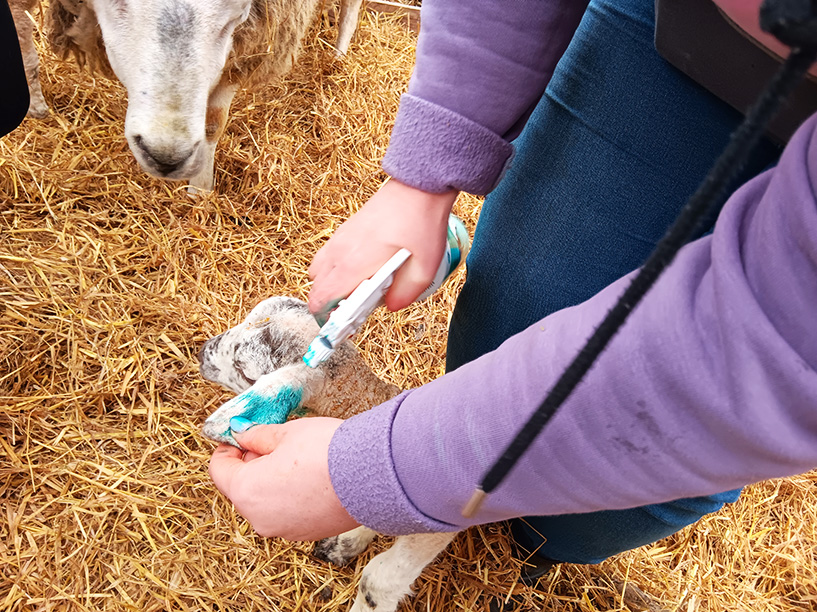12 Nov 2024
Fiona Lovatt shares the findings from this study into a protective solution.

Little is more frustrating than an outbreak of joint ill in the lambing shed, or to find newborn calves facing navel ill infections.
Most people aim to prevent outbreaks by the application of strong iodine to the umbilicus area, and sometimes ear tag sites, via either dip immersion or aerosol spray.
The aim is to desiccate the navel while providing antiseptic activity against surface dwelling bacteria1. Previously, vets would often also advocate routine preventive antibiotic injection in the first few days of life to prevent such infections.
However, routine prophylactic use of antibiotics in this way is no longer considered appropriate, or indeed permitted, under the new Veterinary Medicine Regulations.
Concerns were raised in 2022 over the global supply of iodine, and in that year the reduced availability of iodine caused some prices to triple or quadruple compared to the previous year2.
In response to these concerns, NoBACZ Healthcare developed a long-acting adhesive solution comprising alcohol, the biopolymer “shellac” and essential metal ions3. This product offers a dual-action protection for the navel: the essential desiccation and cleansing using alcohol concentrations, with additional ongoing protection from the shellac and transition metal coating.
The patented combination of these ingredients forms a non-colonisable barrier to bacteria that is waterproof, durable and lasts throughout the desiccation period. A strong blue feed-grade dye is used for good visibility on all fleece/hair types, and the inclusion of a bitter agent to deter dam interference.
Flock Health undertook an informal pilot study of the use of NoBACZ Navel on 440 neonatal lambs and 30 calves on 5 different farms at the end of lambing in 2023; no cases of joint ill were recorded and farmer reports of usability were positive.
Then, during the 2023-2024 lambing period, Flock Health conducted a trial to compare NoBACZ Navel with strong iodine on more than 5,000 lambs across 11 lambing flocks that were already ear-tagging and recording data from birth. Farmers treated the navels and ear tags of each lamb born, carefully alternating with either strong iodine, as per their usual protocol, or NoBACZ Navel.
They recorded cases of joint ill, other disease and deaths, and weighed lambs at birth and at eight weeks old, as is routine for performance-recording flocks. The detailed results and full data analysis was presented at this year’s BCVA Congress on 18 October, with a full paper concurrently submitted for peer review. However, the interim analysis from the first six flocks was presented at the European College for Small Ruminant Health Management’s annual meeting in Turin in early July.
These results indicated equivalent performance between iodine and NoBACZ Navel-treated lambs with respect to the number of cases of farmer-reported joint ill, but importantly, levels of lamb mortality were consistently lower in the NoBACZ Navel-treated lambs compared to the iodine-treated ones.

The author really very much enjoyed undertaking this trial because she and her team were able to collect so much data, a task that is notoriously difficult to achieve from sheep farmers at lambing time.
It really helped that only flocks that were already performance recording were used, so alternating the product they used on their navel and ear treatments was the only modification to their usual lambing routine.
And the farmer feedback has been overwhelmingly positive, which the author said was really encouraging.
Stand-out results are the apparent advantage of NoBACZ Navel over iodine with respect to better lamb survivability, an incredibly exciting result that I am becoming increasingly confident is real as we consider the whole data set.
Otherwise, a further clear take-home message from the trial is the importance of proactive disinfection of ear tag sites.
One of the farms in our trial decided to move to using NoBACZ Navel on all ear tag sites due to concerningly more ear infections and joint ill occurring in their iodine-treated group.
Another shepherd commented that, due to spraying ear tags, they had seen many fewer cases of joint ill than in previous years – and this was despite not routinely injecting with antibiotic this lambing season, as had previously been his regular practice (Panel 1).
Additionally, as a purpose-built solution for navel care, NoBACZ Navel has been shown to be well tolerated by handlers and stock alike, with no adverse reactions reported, plus a positive for handlers in terms of reduced skin irritation when using NoBACZ Navel (Panel 2).
It is not often that genuinely innovative products are produced for the ruminant industry and it is rare that robust and reliable outcome data are collected and analysed from real flocks on such a large scale.
This made it all the more refreshing to be able to share the full results from this trial at BCVA Congress.